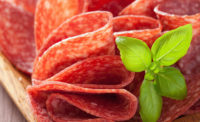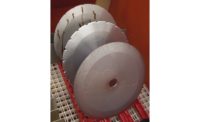Blades of glory: A little TLC goes a long way on slicers
Slicers improve in cut accuracy and waste reduction by staying sharp, flexible, and easy to clean.






Successful slicing operations include, but are not limited to, slicing quality (appropriate thickness, minimal edge tears and broken slices), precise product portioning and for advanced high-speed slicing systems, the ability to make adjustments during slicing with minimal down time, ease of system operation and cleanup, return on investment and maintenance costs, notes Wes Osburn, associate professor, Department of Animal Science, Texas A&M University.
“The software program used to calibrate and operate a slicing system must allow for flexibility to slice a variety of products, programs customized for various product types [with variable salt and fat contents, particle size — emulsion, whole, chopped or restructured, and product shape, size and diameter] and slice thickness, as well as maintain the required product throughput or volume,” he says.
Most slicer blades are constructed from stainless steel as the base material, but may have additional coatings on the blade edge to assist in slicing harder or firmer products, such as cheeses or meat products with cheese or other types of inclusions such as an emulsified product with cured ham chunks, he says.
“In high-speed slicing operations, product temperature, blade sharpness, blade type [circular or sickle] and blade diameter are critical parameters to ensure that the product is sliced accurately with minimum waste,” adds Osburn. “Modern slicing machines have controls that can adjust the rate of product being fed into the slicer to ensure that slice thickness and/or final sliced product weight specifications are met.”
For irregularly shaped products — particularly fresh or marinated subprimals — the use of lasers to generate an optimal product-cutting diagram to hit target portion control weights is also in use by the industry.
“In addition to proper maintenance for sharpening blades, periodic visual observations of slicing are important to address any premature blade wearing,” says Jeff Sindelar, associate professor, extension meat specialist, University of Wisconsin-Madison. “Selection of blades with proper metal hardness is also important for maximum slicing capability.”
Product temperature also affects the effectiveness of the slicing operation. To achieve maximum control of slice quality and yield, temperature control and temperature consistency of the product to be sliced is critical, says Al Booren, professor emeritus, Michigan State University.
Indeed, for bacon, “tempering to proper temperatures that ensure clean slicing without shattering is still paramount,” says Sindelar. Innovations can still be found working through the challenges of belly uniformity within and among bellies being sliced, he says.
From a food-safety standpoint, changes in design to make cleaning easy and thorough are always important — and experts say cleaning and dismantling slicers is certainly critical to facilitate proper and total sanitation.
Looking for a reprint of this article?
From high-res PDFs to custom plaques, order your copy today!












